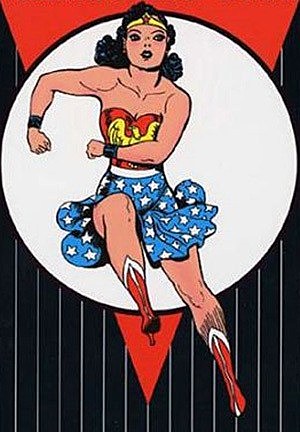Post by simayl on Aug 24, 2016 10:48:58 GMT -5
Wonder Woman is marketed by DC as one of their three top franchises but I have failed to connect with the character when I have attempted to read any of the numerous re-launches over the last twenty five years or so, in fact since George Perez's excellent post Crisis re-launch. However, this all changed when I read the original Wonder Woman stories from the Golden Age by William Moulton Marston and H G Peter. I sometimes struggle with Golden Age books, but there are some characters whose stories are truly excellent and I can recommend Boy Commandos from DC, Captain Marvel from Fawcett and Blackhawk from Quality Comics as being particularly good. I did not think for a moment that Wonder Woman would join this list but she has.
Writer William Moulton Marston, who used the pen name Charles Moulton, was a very interesting and eccentric character himself. A noted psychologist who contributed to the development of the polygraph test he was a feminist who shared his home not only with his wife Elizabeth but with his girlfriend Olive Byrne, who may also have been Elizabeth's lover. Marston wanted to promote his feminist belief in the superiority of women and Wonder Woman was his ideal powerful beauty.
Artist Harry G Peter was equally important in defining Wonder Woman and he created a look which conformed to Marston's ideas about beauty, grace and power. A far cry from the current depictions of the character.
One theme in the tales that cannot pass without comment is bondage. Ropes and chains abound. Our heroine is tied up, supporting characters are tied up, villains are tied up. It makes one speculate about the exact nature of Marston's relationships with Elizabeth and Olive!
If you are prepared to either ignore or embrace these themes you will discover a well-written, pacey, uniquely illustrated series of adventures that will engage you and keep you turning the pages. Marston had a gift for the finely honed phrase and Peter's art is great fun. What true comic fan can resist the Invisible Plane?
Or the "bullets and bracelets" trick?
Or the body positive role model and unique supporting character Etta Candy?
Or the love triangle between Wonder Woman, Steve Trevor and Diana Prince which puts the Lois and Clark relationship in the shade?
Marston died in 1947 and whilst Peter continued to draw the adventures until 1958 the magic was gone and the series drifted through what I would categorise as a teen romance period until Bob Kanigher introduced a Silver Age version but that is another story entirely! If you have yet to take the plunge into the Golden Age of Wonder Woman I urge you to do so at the earliest opportunity. If you have already taken the plunge what do you think about the series?
Writer William Moulton Marston, who used the pen name Charles Moulton, was a very interesting and eccentric character himself. A noted psychologist who contributed to the development of the polygraph test he was a feminist who shared his home not only with his wife Elizabeth but with his girlfriend Olive Byrne, who may also have been Elizabeth's lover. Marston wanted to promote his feminist belief in the superiority of women and Wonder Woman was his ideal powerful beauty.
Artist Harry G Peter was equally important in defining Wonder Woman and he created a look which conformed to Marston's ideas about beauty, grace and power. A far cry from the current depictions of the character.
One theme in the tales that cannot pass without comment is bondage. Ropes and chains abound. Our heroine is tied up, supporting characters are tied up, villains are tied up. It makes one speculate about the exact nature of Marston's relationships with Elizabeth and Olive!
If you are prepared to either ignore or embrace these themes you will discover a well-written, pacey, uniquely illustrated series of adventures that will engage you and keep you turning the pages. Marston had a gift for the finely honed phrase and Peter's art is great fun. What true comic fan can resist the Invisible Plane?
Or the "bullets and bracelets" trick?
Or the body positive role model and unique supporting character Etta Candy?
Or the love triangle between Wonder Woman, Steve Trevor and Diana Prince which puts the Lois and Clark relationship in the shade?
Marston died in 1947 and whilst Peter continued to draw the adventures until 1958 the magic was gone and the series drifted through what I would categorise as a teen romance period until Bob Kanigher introduced a Silver Age version but that is another story entirely! If you have yet to take the plunge into the Golden Age of Wonder Woman I urge you to do so at the earliest opportunity. If you have already taken the plunge what do you think about the series?


